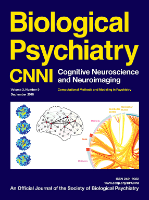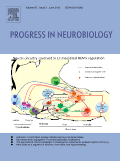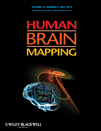
Biological Psychiatry-Cognitive Neuroscience and Neuroimaging
Scope & Guideline
Illuminating the Pathways of Cognitive Neuroscience
Introduction
Aims and Scopes
- Neuroimaging Techniques:
The journal emphasizes the use of advanced neuroimaging techniques such as fMRI, PET, and EEG to explore brain activity and connectivity in relation to mental health disorders. - Cognitive Neuroscience:
Research published in the journal often investigates cognitive processes related to psychiatric disorders, including attention, memory, and executive function, providing insights into how these processes are affected by mental illness. - Transdiagnostic Approaches:
The journal promotes transdiagnostic research that examines commonalities across various psychiatric disorders, facilitating a broader understanding of mental health issues beyond traditional diagnostic boundaries. - Developmental and Lifespan Perspectives:
A significant focus is placed on developmental trajectories of psychiatric disorders, including studies on children, adolescents, and aging populations to understand how psychiatric conditions evolve over time. - Biomarkers and Treatment Responses:
The journal seeks to identify neurobiological markers that can predict treatment responses and outcomes, thereby contributing to personalized medicine in psychiatry. - Integration of Psychosocial Factors:
Research often incorporates psychosocial variables to understand their impact on neurobiological processes, highlighting the interplay between environment, behavior, and brain function.
Trending and Emerging
- Psychedelic Research:
There is a growing interest in the therapeutic potential of psychedelics, with studies exploring their effects on brain function and their implications for treating mood and anxiety disorders. - Machine Learning and Data-Driven Approaches:
The incorporation of machine learning techniques to analyze neuroimaging data and predict treatment outcomes is on the rise, reflecting a trend towards utilizing big data in psychiatric research. - Personalized Medicine:
Research aimed at developing personalized treatment strategies based on neurobiological and genetic profiles is increasingly prominent, highlighting a shift towards tailored therapeutic approaches. - Neurodevelopmental Perspectives:
Emerging themes focus on understanding neurodevelopmental disorders and their trajectories, particularly in relation to early-life experiences and their long-term impacts on mental health. - Neuroinflammation and Psychopathology:
Research examining the role of neuroinflammation in psychiatric disorders is gaining traction, linking immune system functioning with mental health outcomes. - Impact of Societal Factors on Mental Health:
Studies are increasingly addressing how societal and environmental factors, including socioeconomic status and community dynamics, influence brain function and mental health, reflecting a broader understanding of the context in which psychiatric disorders develop.
Declining or Waning
- Focus on Traditional Diagnostic Categories:
There appears to be a waning emphasis on strictly categorical approaches to psychiatric diagnoses, as more researchers are now adopting transdiagnostic frameworks that consider overlapping symptoms and mechanisms. - Basic Neuroscience Studies:
There is a noticeable reduction in purely basic neuroscience studies that do not directly relate to psychiatric conditions, as the journal increasingly prioritizes research with clear clinical implications. - Historical Reviews and Meta-analyses:
The frequency of historical reviews and meta-analyses has declined, suggesting a shift towards original research that presents novel findings rather than synthesizing existing literature.
Similar Journals

CEREBRAL CORTEX
Exploring the intricacies of the brain.CEREBRAL CORTEX, published by Oxford University Press Inc, is a premier journal dedicated to advancing the field of neuroscience, specifically focusing on the cellular, molecular, and cognitive aspects of cortical structure and function. With an impressive impact factor that situates it in the top quartile (Q1) of its categories for 2023, this journal holds significant relevance for researchers and professionals interested in the latest discoveries and methodologies in both Cognitive Neuroscience (ranked #31 out of 115) and Cellular and Molecular Neuroscience (ranked #48 out of 97). Operating without an open access model, it ensures rigorous peer review and dissemination of high-quality research from across the globe. Since its inception in 1991, CEREBRAL CORTEX has established itself as a critical platform for educators and inventors, pushing the boundaries of knowledge in understanding brain function and its implications for behavior. Researchers and students alike will find this journal an invaluable resource for both foundational and cutting-edge studies in neuroscience.

Network Neuroscience
Innovating Insights at the Crossroads of Neuroscience and AINetwork Neuroscience is a premier open-access journal published by MIT Press, focusing on the interdisciplinary nexus of neuroscience, applied mathematics, artificial intelligence, and computer science. Since its inception in 2017, the journal has established itself as a leading outlet for innovative research and cutting-edge methodologies, ensuring disseminated knowledge is freely accessible to all. With an impressive Q1 ranking in multiple categories including Applied Mathematics, Artificial Intelligence, Computer Science Applications, and Neuroscience, it serves as a vital platform for scholars, professionals, and students to explore the intricate networks that underpin cognitive processes and brain function. The journal is committed to advancing the understanding of complex neural mechanisms through interdisciplinary approaches and remains a crucial resource for anyone engaged in the burgeoning fields of network science and neuroscience research.

Brain Communications
Illuminating the Complexities of the Human BrainBrain Communications is an esteemed, open-access academic journal published by Oxford University Press since 2019, focusing on the dynamic field of neuroscience. With a dedicated ISSN and an E-ISSN of 2632-1297, this journal aims to address the intricate relationships between brain functions, psychiatric disorders, and neurobiological mechanisms. The journal stands out in the academic realm, holding a prestigious Q1 ranking across several categories, including Biological Psychiatry, Cellular and Molecular Neuroscience, Neurology, and Psychiatry and Mental Health for 2023. Notably, it has also secured impressive Scopus ranks in various neuroscience and psychiatry fields, evidencing its commitment to high-quality research. With an impact factor reflective of its growing influence, Brain Communications provides accessible research findings to professionals, researchers, and students alike, fostering a deeper understanding of complex neurological phenomena. This innovative journal is pivotal for anyone involved in advancing knowledge in neuroscience and mental health.

Brain Structure & Function
Advancing Neuroscience Through Innovative ResearchBrain Structure & Function is a premier peer-reviewed journal published by Springer Heidelberg, focusing on the intricate relationships between brain anatomy and its functional implications. With a significant presence in the academic community, the journal is recognized for its high impact, evidenced by its rankings in the Q1 categories of Anatomy and Histology and its commendable position in the Neuroscience field. It has successfully maintained a convergence of research and innovation from 2007 to 2024, providing critical insights that drive forward our understanding of the brain. The journal's outstanding metrics, including a ranking of #6 in Anatomy and #18 in Histology within Scopus, highlight its role in shaping modern research. Offering open access options, Brain Structure & Function ensures that its cutting-edge findings and methodologies are accessible to a broad audience of researchers, professionals, and students eager to contribute to the evolution of neuroscience. With its comprehensive scope and commitment to high-quality research, this journal is an essential resource for anyone invested in the complexities of brain structure and their functions.

CORTEX
Transforming Knowledge into Practice in Cognitive ScienceCORTEX is a premier international journal published by Elsevier Masson, focusing on the cutting-edge areas of cognitive neuroscience, psychology, and neurology. With an impressive impact factor that places it in Q1 quartiles across multiple categories such as Cognitive Neuroscience and Neuropsychology, this journal serves as a vital resource for researchers, clinicians, and students alike. Established in 1964, CORTEX has continued to excel in disseminating high-quality scholarly work, offering insights that significantly enhance our understanding of the brain's functioning and behavior. Although not an open-access publication, it provides various access options to ensure the dissemination of knowledge is as wide-reaching as possible. As the field of cognitive psychology evolves, CORTEX remains at the forefront, fostering an environment for interdisciplinary collaboration and innovation. Researchers seeking to stay engaged with the latest advancements will find CORTEX an indispensable tool for their professional development.

BEHAVIOURAL BRAIN RESEARCH
Charting New Territories in Behavioral Brain ScienceBEHAVIOURAL BRAIN RESEARCH, published by Elsevier, is a leading scholarly journal that has been at the forefront of research in Behavioral Neuroscience since its inception in 1980. With an ISSN of 0166-4328 and an e-ISSN of 1872-7549, this journal caters to a global audience of researchers and professionals keen on exploring the intricate relationships between behavior and neural processes. As of 2023, it holds an impressive Q2 ranking within its category, showcasing its significant impact with a Scopus rank of #28 out of 88 in the field, placing it in the 68th percentile. While the journal does not offer open access, it remains accessible through institutional subscriptions, ensuring that its high-quality research is disseminated effectively. The journal's commitment to advancing knowledge in behavioral neuroscience makes it an indispensable resource for those looking to delve deep into the complexities of brain-behavior interactions and foster innovative approaches in both research and clinical applications.

NEUROBIOLOGY OF AGING
Decoding Neurobiological Mechanisms of AgingNEUROBIOLOGY OF AGING, published by Elsevier Science Inc, is a premier journal dedicated to advancing our understanding of the complex interactions between the aging process and neurobiological mechanisms. With an ISSN of 0197-4580 and E-ISSN 1558-1497, the journal has established itself as a critical resource in the fields of Aging, Developmental Biology, Geriatrics and Gerontology, Clinical Neurology, and Neuroscience. Boasting a Q1 ranking in multiple categories, the journal is positioned within the top echelons of scholarly publication, underscoring its significant impact with an impressive Scopus ranking in various subfields. Committed to disseminating high-quality, peer-reviewed research, NEUROBIOLOGY OF AGING welcomes original articles, reviews, and research notes aiming to uncover the underlying processes of aging on the nervous system, fostering collaboration among researchers, professionals, and students alike. Although primarily subscription-based, the journal continues to play a vital role in shaping the discourse on aging and neurobiology, making it an essential publication for those engaged in this dynamic field.

Biological Psychiatry
Advancing insights into the biological roots of mental health.Biological Psychiatry is a premier journal dedicated to advancing the understanding of the biological underpinnings of psychiatric disorders. Published by Elsevier Science Inc, this esteemed journal is recognized globally for its rigorous peer-reviewed research and contributes significantly to the field of biological psychiatry. With an impressive impact factor that places it in Q1 of its category and ranks 3rd out of 51 in Neuroscience Biological Psychiatry, it reflects the journal's strength in disseminating high-quality findings that push the boundaries of knowledge. Since its inception in 1969, the journal has undergone continuous evolution, aiming to integrate biological and clinical perspectives to optimize the understanding of mental health conditions. Although it does not offer open access, Biological Psychiatry serves as a critical resource for researchers, practitioners, and students, offering insights that influence both theoretical frameworks and practical applications in the realm of psychiatric science.

PROGRESS IN NEUROBIOLOGY
Illuminating the Path of Neurobiological ResearchPROGRESS IN NEUROBIOLOGY is a prestigious journal dedicated to advancing the field of neuroscience, published by Pergamon-Elsevier Science Ltd. With an impressive impact factor, it stands as a critical resource for researchers, professionals, and students alike, featuring rigorous peer-reviewed articles that explore the latest developments in neurobiology. The journal has established itself as a leading publication, ranked in the Q1 category for Neuroscience (miscellaneous) and holding a notable 13/113 rank in General Neuroscience per Scopus metrics, placing it in the top 12% of its field. Since its inception in 1959, PROGRESS IN NEUROBIOLOGY has covered a wide array of topics, from molecular mechanisms to cognitive processes, fostering a comprehensive understanding of brain functions. While the journal is not open access, it ensures accessibility to profound knowledge through institutional subscriptions. Researchers and scholars will find critical analyses and innovative research that are pivotal for both foundational knowledge and cutting-edge investigations in the neuroscience realm.

HUMAN BRAIN MAPPING
Advancing the frontiers of neuroscience.HUMAN BRAIN MAPPING, published by Wiley, is a premier journal in the field of neuroscience, devoted to comprehensively advancing understanding of brain structure and function through innovative mapping techniques. With an impressive impact factor and ranked in the Q1 category across multiple relevant disciplines—including Anatomy, Neurology, and Radiology—this journal is recognized as a vital resource for researchers and professionals passionate about the complexities of the human brain. Founded in 1993 and continuously publishing groundbreaking research, HUMAN BRAIN MAPPING is essential for those looking to stay at the forefront of developments in anatomical and neurological research. Though it does not currently offer Open Access options, the journal remains committed to disseminating high-quality research that influences clinical practices and academic inquiry. Its esteemed position within Scopus highlights its significance; charting at the top percentiles across various medical and health fields serves as a testament to the critical contributions made by the authors and researchers involved. As it converges toward 2024, HUMAN BRAIN MAPPING continues to be the go-to platform for publishing pivotal insights into the intricacies of brain mapping methodologies and applications.